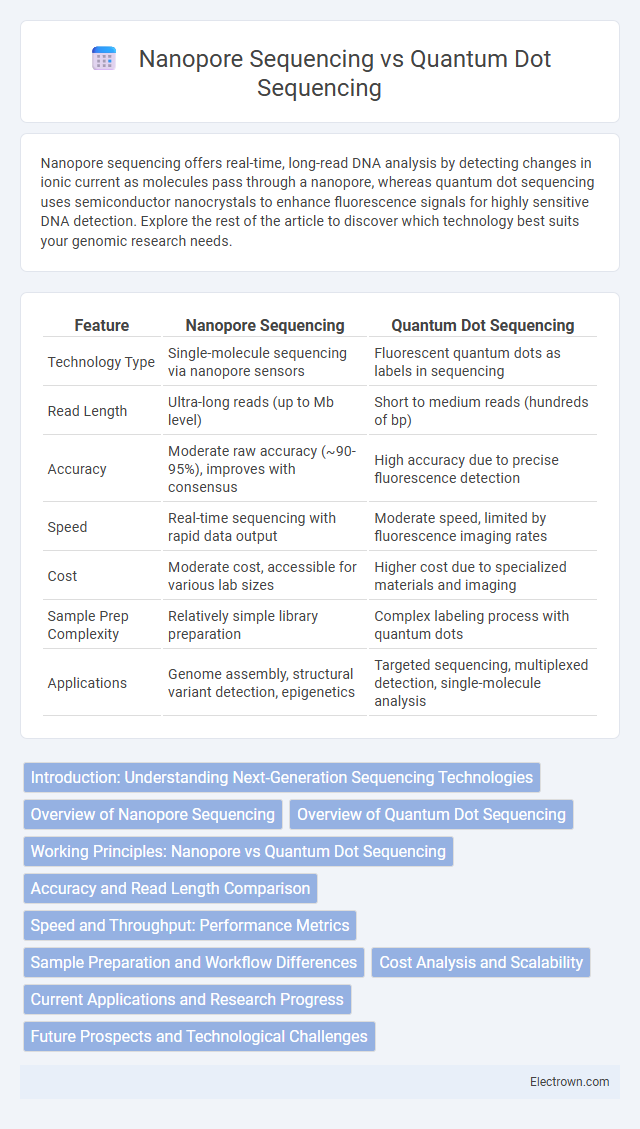Nanopore sequencing offers real-time, long-read DNA analysis by detecting changes in ionic current as molecules pass through a nanopore, whereas quantum dot sequencing uses semiconductor nanocrystals to enhance fluorescence signals for highly sensitive DNA detection. Explore the rest of the article to discover which technology best suits your genomic research needs.
Table of Comparison
| Feature | Nanopore Sequencing | Quantum Dot Sequencing |
|---|---|---|
| Technology Type | Single-molecule sequencing via nanopore sensors | Fluorescent quantum dots as labels in sequencing |
| Read Length | Ultra-long reads (up to Mb level) | Short to medium reads (hundreds of bp) |
| Accuracy | Moderate raw accuracy (~90-95%), improves with consensus | High accuracy due to precise fluorescence detection |
| Speed | Real-time sequencing with rapid data output | Moderate speed, limited by fluorescence imaging rates |
| Cost | Moderate cost, accessible for various lab sizes | Higher cost due to specialized materials and imaging |
| Sample Prep Complexity | Relatively simple library preparation | Complex labeling process with quantum dots |
| Applications | Genome assembly, structural variant detection, epigenetics | Targeted sequencing, multiplexed detection, single-molecule analysis |
Introduction: Understanding Next-Generation Sequencing Technologies
Nanopore sequencing offers real-time, long-read DNA analysis by detecting changes in ionic current as nucleic acids pass through a nanopore, enabling rapid and portable genome sequencing. Quantum dot sequencing utilizes fluorescent quantum dots as molecular probes to achieve high sensitivity and multiplexing capabilities in detecting genetic variations. Both technologies represent innovative strides in next-generation sequencing, enhancing accuracy, speed, and versatility for genomic applications.
Overview of Nanopore Sequencing
Nanopore sequencing utilizes biological nanopores embedded in a membrane to analyze DNA or RNA molecules as they pass through, detecting changes in ionic current to determine nucleotide sequences. This technique offers real-time, label-free sequencing with long read lengths, enabling comprehensive genome analysis and structural variant detection. Its portability, low cost, and minimal sample preparation make nanopore sequencing a versatile tool for research and clinical applications.
Overview of Quantum Dot Sequencing
Quantum Dot Sequencing utilizes fluorescent semiconductor nanocrystals to label nucleotides, enabling highly sensitive and multiplexed detection during DNA sequencing. This method offers advantages in signal stability and brightness over traditional dyes, facilitating real-time analysis with improved accuracy. Quantum Dot Sequencing is particularly valuable in applications requiring precise quantification of genetic variants and high-throughput sequencing workflows.
Working Principles: Nanopore vs Quantum Dot Sequencing
Nanopore sequencing identifies DNA or RNA molecules by detecting changes in ionic current as nucleotides pass through a nanoscale pore, enabling real-time, label-free analysis. Quantum dot sequencing utilizes fluorescent quantum dots attached to nucleotides, where emitted light patterns during DNA synthesis allow precise base identification through optical detection. The fundamental difference lies in nanopore's electrical signal measurement versus quantum dot's fluorescence-based optical readout.
Accuracy and Read Length Comparison
Nanopore sequencing offers long read lengths exceeding 100 kb, enabling comprehensive genome assembly, but exhibits a raw read accuracy typically around 90-95%. Quantum dot sequencing, although less commonly used, provides higher accuracy over 99% due to its fluorescence-based detection, yet suffers from shorter read lengths generally below 1 kb. The trade-off between nanopore's ultra-long reads and quantum dot's superior accuracy impacts their application in genome sequencing, where nanopore excels in structural variation detection and quantum dot favors precise single nucleotide variant identification.
Speed and Throughput: Performance Metrics
Nanopore sequencing offers real-time data acquisition with read speeds exceeding 450 bases per second per nanopore, enabling high-throughput sequencing suitable for rapid genomic analysis. Quantum dot sequencing leverages fluorescent signal intensity with parallelization, achieving moderate throughput but generally slower read rates compared to nanopore platforms. Performance metrics highlight nanopore sequencing's advantage in speed and scalability, while quantum dot sequencing excels in signal specificity and multiplexing capabilities.
Sample Preparation and Workflow Differences
Nanopore sequencing features minimal sample preparation, requiring only DNA or RNA strands without amplification, enabling real-time analysis and simpler workflows. Quantum dot sequencing demands more complex sample preparation, including labeling nucleotides with fluorescent quantum dots and multiple washing steps, which extend overall processing time. Your choice depends on whether faster turnaround or higher multiplexing capacity is prioritized in the sequencing workflow.
Cost Analysis and Scalability
Nanopore sequencing offers lower upfront costs and scalable throughput, making it suitable for both small labs and large-scale projects due to its flexible flow cell options and real-time data generation. Quantum dot sequencing involves higher initial investment in specialized equipment and reagents, limiting cost-effectiveness for large-scale applications despite its high sensitivity. You benefit from nanopore's lower operational expenses and adaptability when prioritizing scalable, cost-efficient sequencing solutions.
Current Applications and Research Progress
Nanopore sequencing is widely applied in real-time DNA and RNA analysis, enabling rapid pathogen detection, epigenetic profiling, and portable genomic diagnostics with advancements in accuracy and throughput. Quantum dot sequencing, leveraging semiconductor nanocrystals for enhanced fluorescence signals, is primarily explored in high-throughput proteomics and multiplexed biomarker detection, showing promising research progress in sensitivity and multiplexing capabilities. Your choice between these technologies depends on whether you prioritize real-time nucleic acid analysis or high-sensitivity protein and biomarker studies in cutting-edge research.
Future Prospects and Technological Challenges
Nanopore sequencing offers real-time, portable DNA analysis with ongoing improvements in accuracy and scalability, positioning it for expansive applications in genomics and personalized medicine. Quantum dot sequencing promises ultra-high sensitivity and multiplexing capabilities by leveraging fluorescent nanocrystals, yet faces significant challenges in integration with biological systems and signal stability. Overcoming these technological hurdles is crucial for advancing both platforms toward widespread clinical and research adoption in next-generation sequencing technologies.
Nanopore Sequencing vs Quantum Dot Sequencing Infographic

 electrown.com
electrown.com